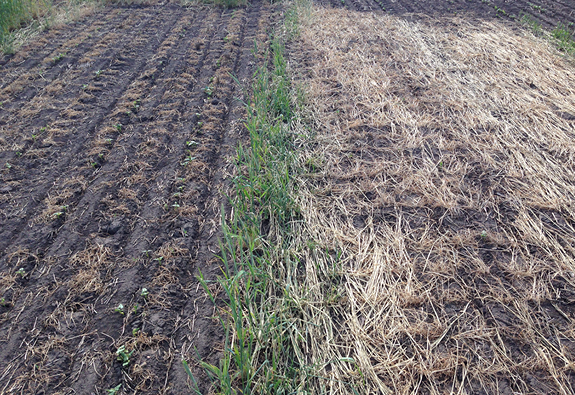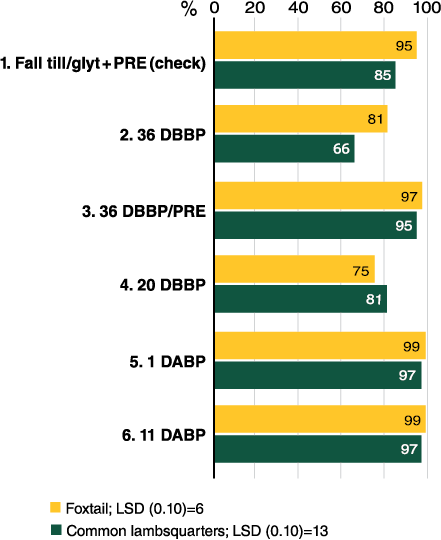Average pinto bean plant population was 50,600, 62,300 and 22,100 plants per acre during 2018, 2019 and 2021 (drought season), respectively. The early season plant densities were 11-68% less than the targeted stand of 70,000 plants per acre. With reduced plant populations in three of four trials trials (2020 average stand was 67,400 plants per acre) compared to the recommended stand, farmers should carefully consider planting rates and procedures when using this production system. In each of the trials, plant stands among trts generally were similar to the conventional system check.
Averaged over four years (2018-21), pinto bean seed yield with rye terminated 29-36 DBBP (trts 2-3) ranged from 1,795-1,855 lb per acre and were statistically similar to the conventional check (trt 1) with 1,750 lb per acre (Table 1). In addition, yield was similar to trt 1 with delaying rye termination 16-20 DBBP (trt 4). These data indicate that yield can be maintained with this production system compared to a conventional system. Yield averaged 1,390 lb per acre with delaying rye termination until near bean planting (trt 5), reducing yield 24% compared to the average yield of trts 2-3. Averaged over three years, delaying rye termination 7-11 DABP (trt 6) reduced yield 36% and 11% compared to yield with trts 2-3 and 5, respectively.
Table 1. Pinto bean seed yield with rye cover crop termination treatments, Carrington, 2018-21.
| Treatment1 |
3-year average (2019-21) |
4-year average |
| No. Description |
lb per acre |
lb per acre |
| 1 Conventional production check |
1945 |
1750 |
| 2 PP glyt 29-36 DBBP |
2025 |
1795 |
| 3 PP glyt 29-36 DBBP/PRE Spartan Charge or Elite |
2060 |
1855 |
| 4 PP glyt 16-20 DBBP |
1965 |
1705 |
| 5 Near planting glyt 5 DBBP to 1 DABP |
1475 |
1390 |
| 6 PRE glyt 7-11 DABP |
1315 |
— |
| LSD 0.05 |
355 |
261 |
¹PP=preplant. Glyt=glyphosate. DBBP=days before bean planting. PRE=pre-emergence. DABP=Days after bean planting.
Averaged over four years, ground cover, measured by the line-transect method one to two DABP, generally was greater with delay of rye termination near or after planting compared to the conventional check and PP termination of rye (Figure 1 and Table 2).
Figure 1. Trt 2 (left) and trt 6 (right) plots at early pinto bean plant emergence (mid-June 2019).
Table 2. Ground cover and topsoil moisture with rye cover crop
termination treatments, Carrington, 2018-21.
| Treatment1 |
Ground cover2 |
Topsoil moisture3 |
| No. Description |
% |
% |
| 1 Conventional production check |
18 |
17.5 |
| 2 PP glyt 29-36 DBBP |
32 |
18.0 |
| 3 PP glyt 29-36 DBBP/PRE Spartan Charge or Elite |
29 |
18.7 |
| 4 PP glyt 16-20 DBBP |
34 |
18.7 |
| 5 Near planting glyt 5 DBBP to 1 DABP |
50 |
15.7 |
| 6 PRE glyt 7-11 DABP |
59 |
— |
| LSD 0.05 |
24 |
2.1 |
¹PP=preplant. Glyt=glyphosate. DBBP=days before bean planting. PRE=pre- emergence. DABP=Days after bean planting.
²Measured previous crop residue and rye using line-transect method 1-2 DABP (2019-21).
³Measured with Extech Instruments MO750 soil moisture meter at 4-inch depth 0-7 DABP.
During each year of pinto bean production, topsoil moisture in the trials was reduced by delaying rye termination until near bean planting (trt 5). In addition, rainfall to replenish soil moisture was less than normal (Figure 2) and not timely. Averaged over four years, topsoil moisture, measured within a week of bean planting, generally was greater with the conventional check (trt 1) and PP termination of rye (trts 2-4) compared to rye termination near bean planting (trt 5) (Table 2). Pinto bean plant development (emergence, flowering and maturity) was extended three to 10 days with trt 5 (Table 3). In addition, bean plant canopy closure was reduced 12-20% with trt 5 compared to other trts.
Figure 2. May and June rainfall, Carrington 2018-21 (NDAWN).1
1NDAWN=North Dakota Agricultural Weather Network
Table 3. Pinto bean plant development and canopy cover
with rye cover crop termination treatments, Carrington, 2018-21.
| |
Planet Development |
|
|
|
| Treatment1 |
Emergence |
Flower |
Maturity |
Canopy2 |
| No. Description |
Day of
year3
|
Day of year3 |
Day of year3 |
% |
| 1 Conventional production check |
164 |
200 |
254 |
74 |
| 2 PP glyt 29-36 DBBP |
164 |
200 |
254 |
69 |
| 3 PP glyt 29-36 DBBP/PRE Spartan Charge or Elite |
163 |
200 |
250 |
75 |
| 4 PP glyt 16-20 DBBP |
34 |
200 |
255 |
68 |
| 5 Near planting glyt 5 DBBP to 1 DABP |
175 |
208 |
258 |
60 |
| LSD 0.05 |
7 |
5 |
6 |
10 |
¹PP=preplant. Glyt=glyphosate. DBBP=days before bean planting. PRE=pre-emergence. DABP=Days after bean planting.
²Day of the year 163 is June 12, 200 is July 19 and 250 is Sept. 7.
³Pinto bean canopy cover measured using Canopeo app during late July-August.
A uniform stand of winter rye will suppress annual weeds through a combination of allelopathy and competition (Ransom et al., 2021). Grass and broadleaf weeds present in this study generally had similar control with the use of PRE herbicides and when rye termination was delayed until or after bean planting, when visually evaluated three to four weeks following planting. For example, in the 2020 trial (Figure 3), green and yellow foxtail control ranged from 95-99% and common lambsquarters control was 85-97% with PRE herbicide (trts 1 and 3) or when rye was allowed to grow until 1-11 DABP (trts 5-6). Rye terminated 20 or 36 DBBP (trts 2 and 4) resulted in 75-81% control of foxtail and 66-81% control of common lambsquarters. Averaged across three years (2018 and 2020-21), foxtail control averaged 87-89% with trts 1, 3 and 5 compared to foxtail control of 71-72% with trts 2 and 4. Weed control generally was reduced with early rye termination (without PRE herbicide) as the lack of live rye and residue allowed weed presence earlier in the growing season.
Figure 3. Weed control in pinto bean among rye termination treatments with glyphosate, Carrington, 2020.1
1Visual evaluation 3 weeks after bean planting (prior to POST herbicide applied across trial for general weed control). DBBP= days before bean planting; DABP = days after bean planting. Glyphosate = Roundup Powermax at 28.4 fl oz/A; PRE = Spartan Elite at 20 fl oz/A. ‘ND Palomino’ direct planted in 30” rows on June 4.



